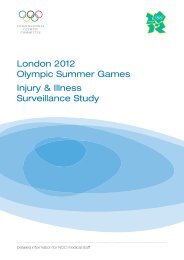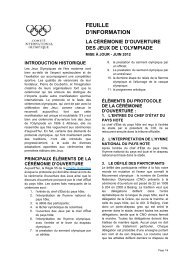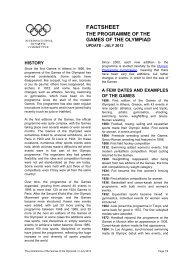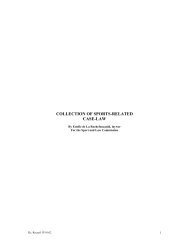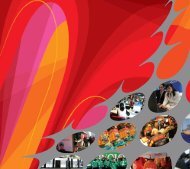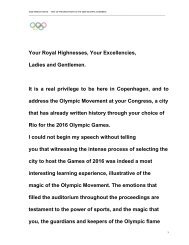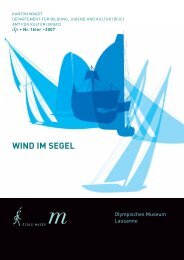8th WORLD CONFERENCE ON SPORT AND THE ENVIRONMENT
8th WORLD CONFERENCE ON SPORT AND THE ENVIRONMENT
8th WORLD CONFERENCE ON SPORT AND THE ENVIRONMENT
You also want an ePaper? Increase the reach of your titles
YUMPU automatically turns print PDFs into web optimized ePapers that Google loves.
<strong>8th</strong> World Conference on Sport and the Environment<br />
International Cooperation and Development Department<br />
Report<br />
groups (Aboriginal, youth at risk, women and new immigrants) are trained for 30 weeks (six<br />
weeks of theoretical teaching and 24 weeks of practical training), where trainees will build about<br />
8,000 Games-time items, including podiums, ramps, and warming huts.<br />
3. Lost & Found Claim Centre: During the 2010 Games, a community group will manage and<br />
operate the Centre. Unclaimed items will become property of the non-profi t organisation, which<br />
will distribute them to the community.<br />
Key message<br />
1. Involving the community<br />
2. Using the purchasing and recruiting powers of the event to generate sustainability outcomes,<br />
such as ethical sourcing and enhancing the social, environmental and economic outcomes of<br />
the Games.<br />
Ms Duffy described the case study of VANOC’s Buy Smart Programme, which includes policies and<br />
procedures, codes of conduct, a steering committee, and audits. She stated that all merchandise<br />
products go through a Licensing Code of Conduct, be they plush toys, pins, etc. This includes a<br />
several-step process:<br />
1. Pre-contract audit<br />
2. The licensees are signed up if successful<br />
3. Annual site audit<br />
4. Tracking and reporting<br />
5. Corrective action plans if defi ciencies are found.<br />
Topic: Smart Transportation and Accommodation<br />
by Ms Ann Duffy,<br />
Corporate Sustainability Offi cer, VANOC<br />
An organising committee must optimise its fl eet size and composition, collaborate with government<br />
on public transport, and communicate with hotels on sustainable accommodation.<br />
Travel Planning: This involves reducing energy consumption, greenhouse gas emissions, air<br />
pollution, travel time and money.<br />
Green Accommodation: Mention of the Green Key Programme by the Canadian Hotel Association<br />
with various levels of green and social programming.<br />
Green Travel: Options are teletrips, airline offsets, public transportation use, green fl eets.<br />
VANOC’s 2010 Carbon Strategy was also discussed. VANOC’s strategy has been a four-part<br />
process:<br />
1. Know the inventory of emissions and report – where, when, how much?<br />
2. Reduce as many emissions as possible at the source, including through choice of materials,<br />
energy effi cient venues.<br />
3. Be Responsible: Offset direct and indirect emissions that cannot be reduced or eliminated.<br />
4. Align and Activate with Others: Use the 2010 experience to increase awareness of and<br />
participation in climate change solutions, including viewers, athletes, sponsors, etc.<br />
VANOC’s footprint scope includes Direct Emissions (what they control) that are generated by the<br />
staging of the Games, such as venues, villages, operations and transportation, air travel; as well<br />
as the Indirect Emissions that they infl uence, including Games-times air travel.<br />
Key message<br />
1. Choosing smart travel and accommodation infl uences the supply chain and environment;<br />
2. Saves time and money.<br />
Page 21 / 80






